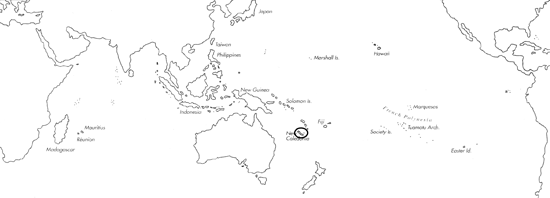
Skip Navigation Links
View access keys for this site.

Range: New Caledonia.
Description: Medium-sized to moderately large, moderately solid to solid. Last whorl conical or ventricosely conical, outline convex adapically, less so or straight below. Shoulder angulate. Spire low; outline concave, straight or sigmoid in adults, domed in subadults. Larval shell multispiral, maximum diameter 0.8-0.9 mm. Teleoconch sutural ramps with 1 increasing to 3-5 weak spiral grooves. Last whorl with prominent spiral rows of granules toward base; interspaces with an usually weaker central row of granules.
| Shell Morphometry | ||
|---|---|---|
| L | 36-62 mm | |
| RW | 0.18-0.41 g/mm | |
| ((L 36-55 mm)) | ||
| RD | 0.51-0.61 | |
| PMD | 0.80-0.91 | |
| RSH | 0.07-0.11 | |
Ground colour white. Last whorl with large orange to brown blotches and orange or orangish brown axial flames, leaving a continuous or interrupted spiral ground-colour band below centre. About 23-30 solid dark brown spiral lines extend from base to shoulder. Base deep violet. Juveniles either immaculate pale rose except for violet base or with colour pattern similar to that of adults except for "more or less missing spiral lines" (Estival & von Cosel, 1986). Larval shell beige. Teleoconch sutural ramps with brown radial markings. Aperture white except for deep violet anterior end.
Animal yellow (Estival, 1981).
Habitat and Habits: In 12 to more than 60 m (Richard, pers. comm., 1991). Estival (198 1) reported juveniles from "the outer side of barrier-reef in sand, deeper than 40 m". According to Estival & von Cosel (1986) and Tirard (pers. comm., 1989), C. swainsoni occurs in 12-25 m on coarse muddy sand with algae and rubble.
Discussion: This species is very similar to C. cilrumactus. The latter species has a broader last whorl (RD 0.58-0.68) and a concave spire rather than with domed early whorls. Juvenile shells (length about 20 mm) (Pl. 22, Fig. 10) of these two species differ strikingly in shape and colour pattern, and they do not appear to intergrade where they co-occur in New Caledonia. C. planorbis, C. ,ferrugineus and C. striatellus also tend to have somewhat broader last whorls. The anterior end of the aperture is white in C. ferrugineus and C. striatellus, violet-brown in C. planorhis but deep violet in C. swainsoni. C. striatellus also differs in having a greater number of more closely spaced spiral lines on the last whorl.

C. swainsoni range map
This section contains verbatim reproductions of the accounts of 316 species of Conus from the Indo-Pacific region, from Manual of the Living Conidae, by Röckel, Korn and Kohn (1995). They are reproduced with the kind permission of the present publisher, Conchbooks.
All plates and figures referred to in the text are also in Röckel, Korn & Kohn, 1995. Manual of the Living Conidae Vol. 1: Indo-Pacific Region.
The range maps have been modified so that each species account has it own map, rather than one map that showed the ranges of several species in the original work. This was necessary because each species account is on a separate page on the website and not confined to the order of accounts in the book.
Return to framed version (returns to search page)